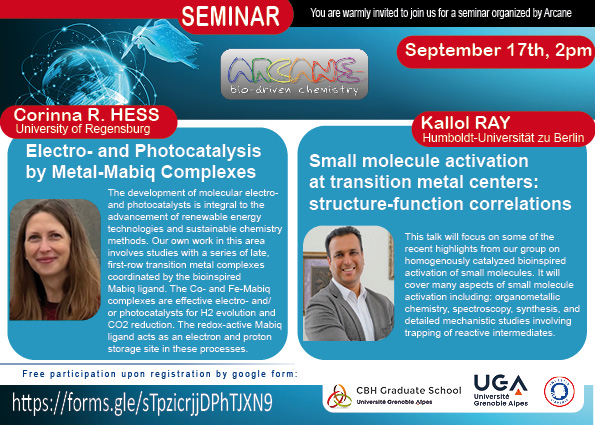- Share
- Share on Facebook
- Share on X
- Share on LinkedIn
Seminar / Research
On September 17, 2024
Saint-Martin-d'Hères - Domaine universitaire

Registration is now open for the Arcane seminar on September 17th at:
https://docs.google.com/forms/d/e/1FAIpQLScQ-XDWsRfVjr-xpD6h7Ek0ztEkUCRcveVUWcRv79RpPkwzkA/viewform?usp=sf_link
Seminar program:
2pm-3pm Corinna Hess - University of Regensburg
Electro- and Photocatalysis by Metal-Mabiq Complexes
The development of molecular electro- and photocatalysts is integral to the advancement of renewable energy technologies and sustainable chemistry methods. Our own work in this area involves studies with a series of late, first-row transition metal complexes coordinated by the bioinspired Mabiq ligand. The Co- and Fe-Mabiq complexes are effective electro- and/or photocatalysts for H2 evolution and CO2 reduction. The redox-active Mabiq ligand acts as an electron and proton storage site in these processes. The series of Mabiq complexes also exhibit unique photochemical properties that allow their application in photoredox catalysis. Our Ni- and Co-Mabiq complexes can promote a range of light-driven C-C and C-N bond forming reactions. Inclusion of a neighboring metal in the second Mabiq binding site significantly alters the redox properties, photochemical behavior and reactivity of the complexes. For example, Cu/Fe-Mabiq acts as a photocatalyst for CO2 to CO conversion in the absence of an added photosensitizer. The binuclear systems offer new opportunities for small molecule and organic functionalization reactions.
3pm-4pm Kallol Ray - Humboldt-Universität zu Berlin
Small molecule activation at transition metal centers: structure-function correlations
4pm-5m Convival break
Date
from 2pm to 4pm
Localisation
Saint-Martin-d'Hères - Domaine universitaire
coming soon
- Share
- Share on Facebook
- Share on X
- Share on LinkedIn